Thomas Scialom
Jack
The Llama 3 Herd of Models
Jul 31, 2024Abstract:Modern artificial intelligence (AI) systems are powered by foundation models. This paper presents a new set of foundation models, called Llama 3. It is a herd of language models that natively support multilinguality, coding, reasoning, and tool usage. Our largest model is a dense Transformer with 405B parameters and a context window of up to 128K tokens. This paper presents an extensive empirical evaluation of Llama 3. We find that Llama 3 delivers comparable quality to leading language models such as GPT-4 on a plethora of tasks. We publicly release Llama 3, including pre-trained and post-trained versions of the 405B parameter language model and our Llama Guard 3 model for input and output safety. The paper also presents the results of experiments in which we integrate image, video, and speech capabilities into Llama 3 via a compositional approach. We observe this approach performs competitively with the state-of-the-art on image, video, and speech recognition tasks. The resulting models are not yet being broadly released as they are still under development.
WorldSense: A Synthetic Benchmark for Grounded Reasoning in Large Language Models
Nov 27, 2023Abstract:We propose WorldSense, a benchmark designed to assess the extent to which LLMs are consistently able to sustain tacit world models, by testing how they draw simple inferences from descriptions of simple arrangements of entities. Worldsense is a synthetic benchmark with three problem types, each with their own trivial control, which explicitly avoids bias by decorrelating the abstract structure of problems from the vocabulary and expressions, and by decorrelating all problem subparts with the correct response. We run our benchmark on three state-of-the-art chat-LLMs (GPT3.5, GPT4 and Llama2-chat) and show that these models make errors even with as few as three objects. Furthermore, they have quite heavy response biases, preferring certain responses irrespective of the question. Errors persist even with chain-of-thought prompting and in-context learning. Lastly, we show that while finetuning on similar problems does result in substantial improvements -- within- and out-of-distribution -- the finetuned models do not generalise beyond a constraint problem space.
GAIA: a benchmark for General AI Assistants
Nov 21, 2023



Abstract:We introduce GAIA, a benchmark for General AI Assistants that, if solved, would represent a milestone in AI research. GAIA proposes real-world questions that require a set of fundamental abilities such as reasoning, multi-modality handling, web browsing, and generally tool-use proficiency. GAIA questions are conceptually simple for humans yet challenging for most advanced AIs: we show that human respondents obtain 92\% vs. 15\% for GPT-4 equipped with plugins. This notable performance disparity contrasts with the recent trend of LLMs outperforming humans on tasks requiring professional skills in e.g. law or chemistry. GAIA's philosophy departs from the current trend in AI benchmarks suggesting to target tasks that are ever more difficult for humans. We posit that the advent of Artificial General Intelligence (AGI) hinges on a system's capability to exhibit similar robustness as the average human does on such questions. Using GAIA's methodology, we devise 466 questions and their answer. We release our questions while retaining answers to 300 of them to power a leader-board available at https://huggingface.co/gaia-benchmark.
Code Llama: Open Foundation Models for Code
Aug 25, 2023
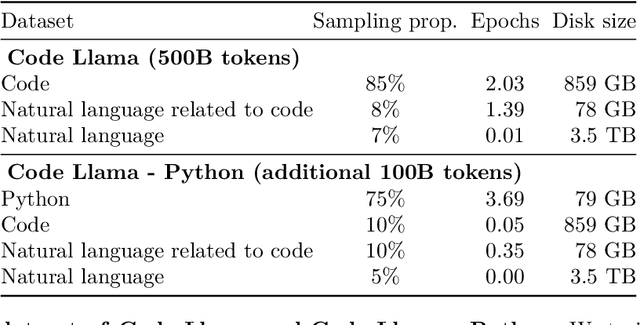

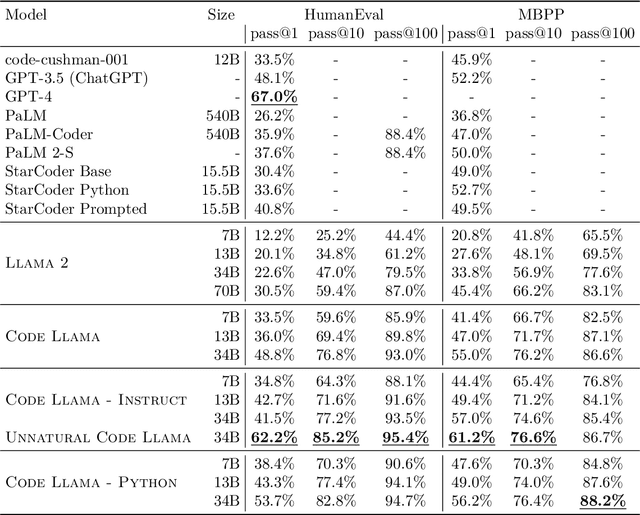
Abstract:We release Code Llama, a family of large language models for code based on Llama 2 providing state-of-the-art performance among open models, infilling capabilities, support for large input contexts, and zero-shot instruction following ability for programming tasks. We provide multiple flavors to cover a wide range of applications: foundation models (Code Llama), Python specializations (Code Llama - Python), and instruction-following models (Code Llama - Instruct) with 7B, 13B and 34B parameters each. All models are trained on sequences of 16k tokens and show improvements on inputs with up to 100k tokens. 7B and 13B Code Llama and Code Llama - Instruct variants support infilling based on surrounding content. Code Llama reaches state-of-the-art performance among open models on several code benchmarks, with scores of up to 53% and 55% on HumanEval and MBPP, respectively. Notably, Code Llama - Python 7B outperforms Llama 2 70B on HumanEval and MBPP, and all our models outperform every other publicly available model on MultiPL-E. We release Code Llama under a permissive license that allows for both research and commercial use.
Nougat: Neural Optical Understanding for Academic Documents
Aug 25, 2023Abstract:Scientific knowledge is predominantly stored in books and scientific journals, often in the form of PDFs. However, the PDF format leads to a loss of semantic information, particularly for mathematical expressions. We propose Nougat (Neural Optical Understanding for Academic Documents), a Visual Transformer model that performs an Optical Character Recognition (OCR) task for processing scientific documents into a markup language, and demonstrate the effectiveness of our model on a new dataset of scientific documents. The proposed approach offers a promising solution to enhance the accessibility of scientific knowledge in the digital age, by bridging the gap between human-readable documents and machine-readable text. We release the models and code to accelerate future work on scientific text recognition.
Llama 2: Open Foundation and Fine-Tuned Chat Models
Jul 19, 2023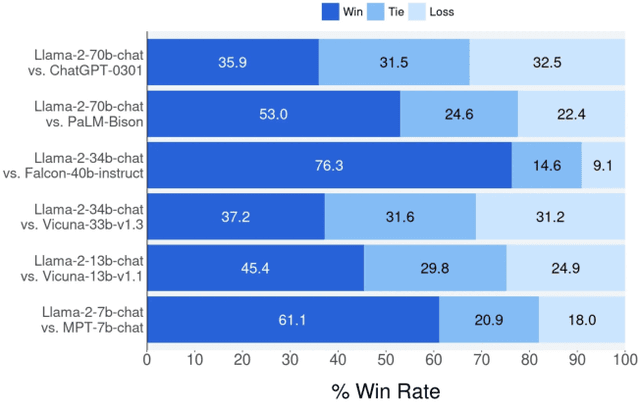

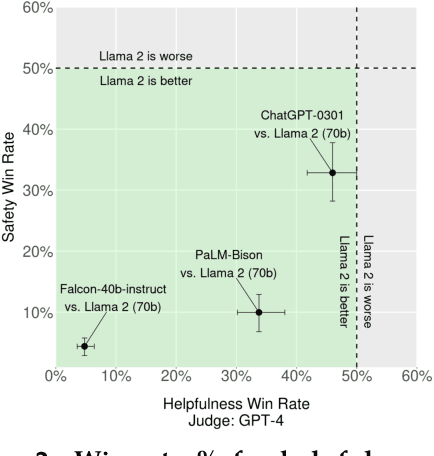

Abstract:In this work, we develop and release Llama 2, a collection of pretrained and fine-tuned large language models (LLMs) ranging in scale from 7 billion to 70 billion parameters. Our fine-tuned LLMs, called Llama 2-Chat, are optimized for dialogue use cases. Our models outperform open-source chat models on most benchmarks we tested, and based on our human evaluations for helpfulness and safety, may be a suitable substitute for closed-source models. We provide a detailed description of our approach to fine-tuning and safety improvements of Llama 2-Chat in order to enable the community to build on our work and contribute to the responsible development of LLMs.
Augmented Language Models: a Survey
Feb 15, 2023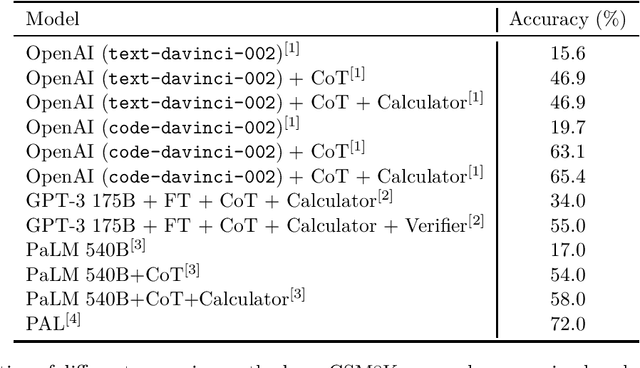

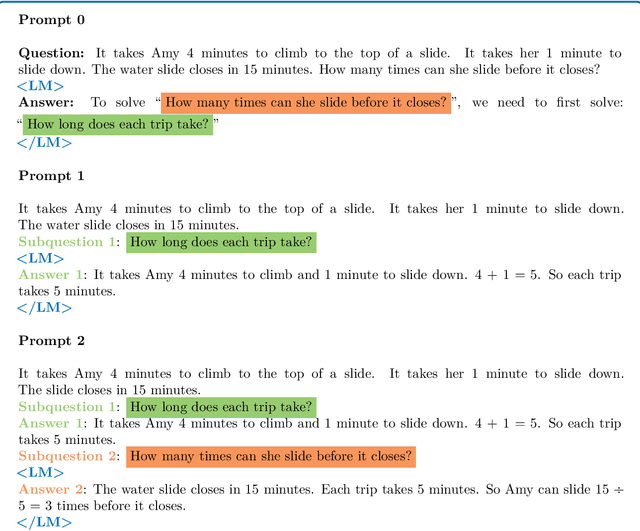

Abstract:This survey reviews works in which language models (LMs) are augmented with reasoning skills and the ability to use tools. The former is defined as decomposing a potentially complex task into simpler subtasks while the latter consists in calling external modules such as a code interpreter. LMs can leverage these augmentations separately or in combination via heuristics, or learn to do so from demonstrations. While adhering to a standard missing tokens prediction objective, such augmented LMs can use various, possibly non-parametric external modules to expand their context processing ability, thus departing from the pure language modeling paradigm. We therefore refer to them as Augmented Language Models (ALMs). The missing token objective allows ALMs to learn to reason, use tools, and even act, while still performing standard natural language tasks and even outperforming most regular LMs on several benchmarks. In this work, after reviewing current advance in ALMs, we conclude that this new research direction has the potential to address common limitations of traditional LMs such as interpretability, consistency, and scalability issues.
Toolformer: Language Models Can Teach Themselves to Use Tools
Feb 09, 2023



Abstract:Language models (LMs) exhibit remarkable abilities to solve new tasks from just a few examples or textual instructions, especially at scale. They also, paradoxically, struggle with basic functionality, such as arithmetic or factual lookup, where much simpler and smaller models excel. In this paper, we show that LMs can teach themselves to use external tools via simple APIs and achieve the best of both worlds. We introduce Toolformer, a model trained to decide which APIs to call, when to call them, what arguments to pass, and how to best incorporate the results into future token prediction. This is done in a self-supervised way, requiring nothing more than a handful of demonstrations for each API. We incorporate a range of tools, including a calculator, a Q\&A system, two different search engines, a translation system, and a calendar. Toolformer achieves substantially improved zero-shot performance across a variety of downstream tasks, often competitive with much larger models, without sacrificing its core language modeling abilities.
LoRaLay: A Multilingual and Multimodal Dataset for Long Range and Layout-Aware Summarization
Jan 26, 2023Abstract:Text Summarization is a popular task and an active area of research for the Natural Language Processing community. By definition, it requires to account for long input texts, a characteristic which poses computational challenges for neural models. Moreover, real-world documents come in a variety of complex, visually-rich, layouts. This information is of great relevance, whether to highlight salient content or to encode long-range interactions between textual passages. Yet, all publicly available summarization datasets only provide plain text content. To facilitate research on how to exploit visual/layout information to better capture long-range dependencies in summarization models, we present LoRaLay, a collection of datasets for long-range summarization with accompanying visual/layout information. We extend existing and popular English datasets (arXiv and PubMed) with layout information and propose four novel datasets -- consistently built from scholar resources -- covering French, Spanish, Portuguese, and Korean languages. Further, we propose new baselines merging layout-aware and long-range models -- two orthogonal approaches -- and obtain state-of-the-art results, showing the importance of combining both lines of research.
Unnatural Instructions: Tuning Language Models with (Almost) No Human Labor
Dec 19, 2022Abstract:Instruction tuning enables pretrained language models to perform new tasks from inference-time natural language descriptions. These approaches rely on vast amounts of human supervision in the form of crowdsourced datasets or user interactions. In this work, we introduce Unnatural Instructions: a large dataset of creative and diverse instructions, collected with virtually no human labor. We collect 64,000 examples by prompting a language model with three seed examples of instructions and eliciting a fourth. This set is then expanded by prompting the model to rephrase each instruction, creating a total of approximately 240,000 examples of instructions, inputs, and outputs. Experiments show that despite containing a fair amount of noise, training on Unnatural Instructions rivals the effectiveness of training on open-source manually-curated datasets, surpassing the performance of models such as T0++ and Tk-Instruct across various benchmarks. These results demonstrate the potential of model-generated data as a cost-effective alternative to crowdsourcing for dataset expansion and diversification.
 Add to Chrome
Add to Chrome Add to Firefox
Add to Firefox Add to Edge
Add to Edge